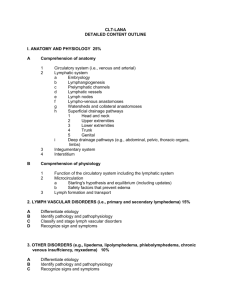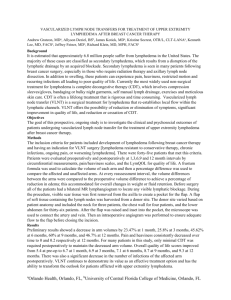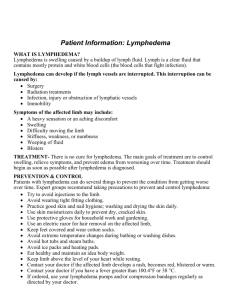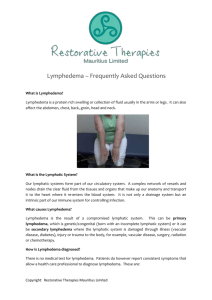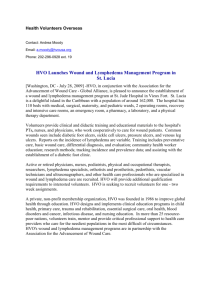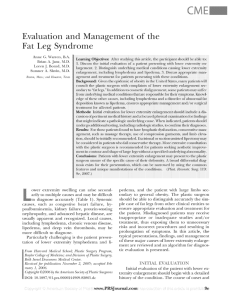Lipedema, a frequently unrecognized problem
advertisement
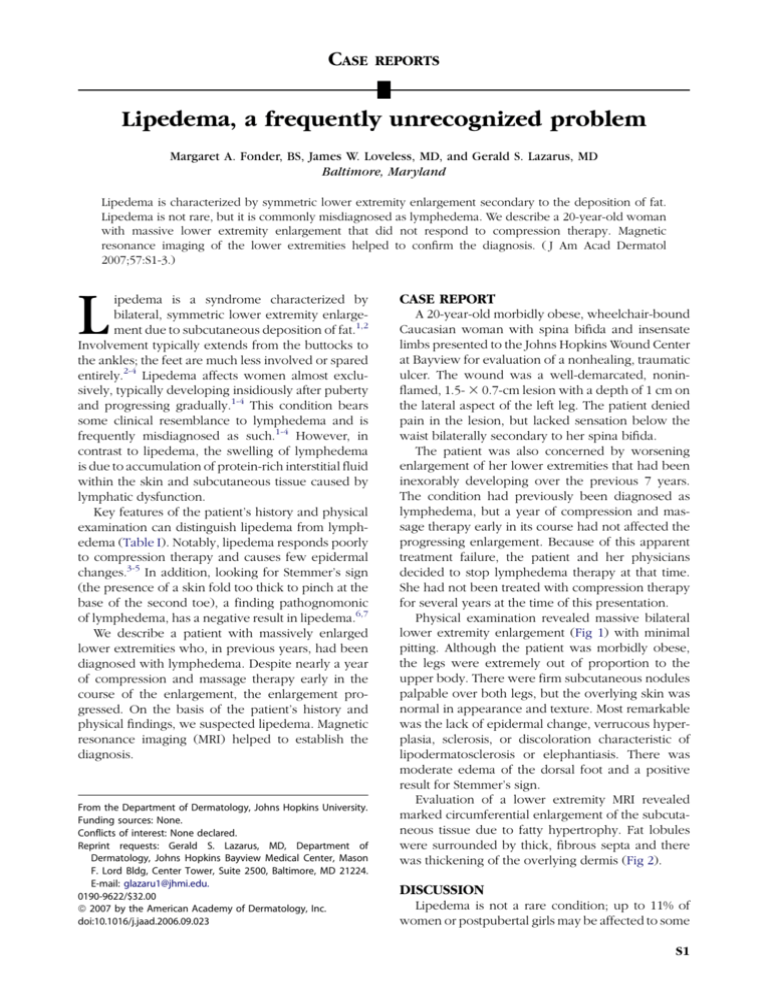
CASE REPORTS Lipedema, a frequently unrecognized problem Margaret A. Fonder, BS, James W. Loveless, MD, and Gerald S. Lazarus, MD Baltimore, Maryland Lipedema is characterized by symmetric lower extremity enlargement secondary to the deposition of fat. Lipedema is not rare, but it is commonly misdiagnosed as lymphedema. We describe a 20-year-old woman with massive lower extremity enlargement that did not respond to compression therapy. Magnetic resonance imaging of the lower extremities helped to confirm the diagnosis. ( J Am Acad Dermatol 2007;57:S1-3.) L ipedema is a syndrome characterized by bilateral, symmetric lower extremity enlargement due to subcutaneous deposition of fat.1,2 Involvement typically extends from the buttocks to the ankles; the feet are much less involved or spared entirely.2-4 Lipedema affects women almost exclusively, typically developing insidiously after puberty and progressing gradually.1-4 This condition bears some clinical resemblance to lymphedema and is frequently misdiagnosed as such.1-4 However, in contrast to lipedema, the swelling of lymphedema is due to accumulation of protein-rich interstitial fluid within the skin and subcutaneous tissue caused by lymphatic dysfunction. Key features of the patient’s history and physical examination can distinguish lipedema from lymphedema (Table I). Notably, lipedema responds poorly to compression therapy and causes few epidermal changes.3-5 In addition, looking for Stemmer’s sign (the presence of a skin fold too thick to pinch at the base of the second toe), a finding pathognomonic of lymphedema, has a negative result in lipedema.6,7 We describe a patient with massively enlarged lower extremities who, in previous years, had been diagnosed with lymphedema. Despite nearly a year of compression and massage therapy early in the course of the enlargement, the enlargement progressed. On the basis of the patient’s history and physical findings, we suspected lipedema. Magnetic resonance imaging (MRI) helped to establish the diagnosis. From the Department of Dermatology, Johns Hopkins University. Funding sources: None. Conflicts of interest: None declared. Reprint requests: Gerald S. Lazarus, MD, Department of Dermatology, Johns Hopkins Bayview Medical Center, Mason F. Lord Bldg, Center Tower, Suite 2500, Baltimore, MD 21224. E-mail: glazaru1@jhmi.edu. 0190-9622/$32.00 ª 2007 by the American Academy of Dermatology, Inc. doi:10.1016/j.jaad.2006.09.023 CASE REPORT A 20-year-old morbidly obese, wheelchair-bound Caucasian woman with spina bifida and insensate limbs presented to the Johns Hopkins Wound Center at Bayview for evaluation of a nonhealing, traumatic ulcer. The wound was a well-demarcated, noninflamed, 1.5- 3 0.7-cm lesion with a depth of 1 cm on the lateral aspect of the left leg. The patient denied pain in the lesion, but lacked sensation below the waist bilaterally secondary to her spina bifida. The patient was also concerned by worsening enlargement of her lower extremities that had been inexorably developing over the previous 7 years. The condition had previously been diagnosed as lymphedema, but a year of compression and massage therapy early in its course had not affected the progressing enlargement. Because of this apparent treatment failure, the patient and her physicians decided to stop lymphedema therapy at that time. She had not been treated with compression therapy for several years at the time of this presentation. Physical examination revealed massive bilateral lower extremity enlargement (Fig 1) with minimal pitting. Although the patient was morbidly obese, the legs were extremely out of proportion to the upper body. There were firm subcutaneous nodules palpable over both legs, but the overlying skin was normal in appearance and texture. Most remarkable was the lack of epidermal change, verrucous hyperplasia, sclerosis, or discoloration characteristic of lipodermatosclerosis or elephantiasis. There was moderate edema of the dorsal foot and a positive result for Stemmer’s sign. Evaluation of a lower extremity MRI revealed marked circumferential enlargement of the subcutaneous tissue due to fatty hypertrophy. Fat lobules were surrounded by thick, fibrous septa and there was thickening of the overlying dermis (Fig 2). DISCUSSION Lipedema is not a rare condition; up to 11% of women or postpubertal girls may be affected to some S1 S2 Fonder, Loveless, and Lazarus J AM ACAD DERMATOL AUGUST 2007 Table I. Characteristics distinguishing lipedema and lymphedema1-5,7-11 Clinical feature* Lipedema Lymphedema Gender Age at onset Distribution Women almost exclusively Often around puberty Bilateral lower extremities, symmetric involvement Absent Absent, negative Stemmer’s sign Present Soft, minimally pitting Common with pressure Present Minimal Women and men Any age Unilateral, or one leg affected more severely Present Present, positive Stemmer’s sign Absent Firm, often markedly pitting Uncommon Absent Marked Frequent Uncommon Less common Frequent No Homogenous increase in subcutaneous fat with little/no fibrosis, no skin thickening Yes Honeycomb pattern fibrosis, edema fluid, skin thickening Epidermal change Foot involvement Buttock involvement Nature of swelling Tenderness Easy bruising of affected area Improvement with elevation and compression Family history History of cellulitis, lymphangitis, and venous disease Angiosarcoma risk MRI findings MRI, Magnetic resonance imaging. *Features of both lipedema and lymphedema may be present in patients with lipolymphedema. Fig 1. Massively enlarged lower extremity with firm subcutaneous fatty nodules but little epidermal change. degree.8 The diagnosis is frequently missed because clinicians lack familiarity with lipedema and because it clinically resembles lymphedema.1-4 In lymphedema, lymphatic dysfunction causes protein-rich interstitial fluid to accumulate within the skin and subcutaneous tissue, producing swelling. In contrast, lipedema results from the subcutaneous deposition of fat and occurs independently of lymphatic or venous insufficiency.3,7,9 Patient history and physical examination are usually sufficient to differentiate lipedema from lymphedema (Table I), although when lipedema has persisted for several years, the distinction may become blurred. Patients with severe, long-standing lipedema may eventually develop mechanical insufficiency of the lymphatic system and superimposed lymphedema, producing ‘‘lipolymphedema’’7,8 In lipolymphedema, the initially soft lipedematous tissue may become firm and nodular. Foot enlargement, including a positive Stemmer’s sign, may develop (Fig 3).7,8 Progression to lipolymphedema has likely occurred in our patient. The bilateral symmetry and lack of epidermal change support a diagnosis of lipedema, but the firm subcutaneous nodules, moderately edematous dorsal aspect of the foot, and positive Stemmer sign suggest superimposed lymphatic involvement. Because our patient’s clinical features were complicated, we reviewed a lower extremity MRI to help clarify the diagnosis. Findings consistent with both lipedema and lymphedema were apparent (Fig 2, Table I), pointing to a diagnosis of lipolymphedema.10,11 The etiology of lipedema is unknown. Many patients with lipedema have a family history of similarly enlarged legs,1,2,4 suggesting a genetic basis. The body’s hormonal milieu also appears to play a role, given that lipedema occurs almost exclusively in women and onset occurs typically during puberty or other periods of hormonal change, including pregnancy and menopause.1-4,7,8 Moreover, the rare cases of lipedema in males have tended to be in patients with hepatic cirrhosis or in men receiving hormonal therapy (eg, for prostatic carcinoma).7,8 Although obese patients may be overrepresented among those with lipedema, persons of normal weight are also commonly affected.1-4 Thus obesity itself is unlikely J AM ACAD DERMATOL Fonder, Loveless, and Lazarus S3 VOLUME 57, NUMBER 2 Fig 3. Assessing Stemmer’s sign. A positive Stemmer’s sign is a skin fold at the base of the second toe too thick to lift. In this image, Stemmer’s sign is negative because the skin lifts normally when pinched. edema.3,5 Perhaps if our patient had consistently received compression, the complicating lymphedematous component might not have developed. Once the progression to lipolymphedema has occurred, as in our patient, lymphedema therapy (reviewed in Macdonald, Sims, and Mayrovitz7) is required. We thank Jens Vogel-Claussen, MD, of the Johns Hopkins University Department of Radiology, for reading the MRIs. Fig 2. A, Axial and B, coronal T1-weighted lower extremity MRIs show massive circumferential enlargement of the subcutaneous tissue occupied by fat lobules and fibrous septa. to be a major determinant of this syndrome. There are no known associations of lipedema with spina bifida or paraplegia, nor are there any described lipedemaassociated congenital syndromes. Lipedema does not predispose a person to ulcer development.3 Treatment options for lipedema are limited. Dieting, diuretics, leg elevation, and compression appear to be of minimal benefit,1-5,7 and attempts to treat invasively via lipectomy or liposuction4,12 are not recommended because they risk causing mechanical damage to the lymphatics.7,8 Macdonald, Sims, and Mayrovitz7 remarked that ‘‘[p]erhaps the most important service provided by the physician is emotional support and reassurance that this disability is not the patient’s fault.’’ Although long-term low-level compression therapy is unlikely to reverse lipedema, it may help prevent its worsening and progression to lipolymph- REFERENCES 1. Allen EV, Hines EA. Lipedema of the legs: a syndrome characterized by fat legs and orthostatic edema. Proc Staff Meet Mayo Clin 1940;15:184-7. 2. Wold LE, Hines EA, Allen EV. Lipedema of the legs: a syndrome characterized by fat legs and edema. Ann Intern Med 1951;34: 1243-50. 3. Beninson J, Edelglass JW. Lipedema — the non-lymphatic masquerader. Angiology 1984;35:506-10. 4. Rudkin GH, Miller TA. Lipedema: a clinical entity distinct from lymphedema. Plast Reconstr Surg 1994;94:841-7. 5. Stallworth JM, Hennigar GR, Jonsson HT, Rodriguez O. The chronically swollen painful extremity: a detailed study for possible etiological factors. JAMA 1974;228:1656-9. 6. Stemmer R. Stemmer’s sign — possibilities and limits of clinical diagnosis of lymphedema. Wien Med Wochenschr 1999;149:85-6. 7. Macdonald JM, Sims N, Mayrovitz HN. Lymphedema, lipedema, and the open wound: the role of compression therapy. Surg Clin North Am 2003;83:639-58. 8. Földi E, Földi M. Lipedema. In: Földi M, Földi E, Kubik S, editors. Textbook of lymphology. Jena, Germany: Urban & Fischer; 2003. pp. 395-403. 9. Harwood CA, Bull RH, Evans J, Mortimer PS. Lymphatic and venous function in lipoedema. Br J Dermatol 1996;134:1-6. 10. Dimakakos PB, Stefanopoulos T, Antoniades P, Antoniou A, Gouliamos A, Rizos D. MRI and ultrasonographic findings in the investigation of lymphedema and lipedema. Int Surg 1997;82:411-6. 11. Duewell S, Hagspiel KD, Zuber J, von Schulthess GK, Bollinger A, Fuchs WA. Swollen lower extremity: role of MR imaging. Radiology 1992;184:227-31. 12. Rank BK, Wong GSC. Lipoedema. Aust N Z J Surg 1966;35:165-9.

